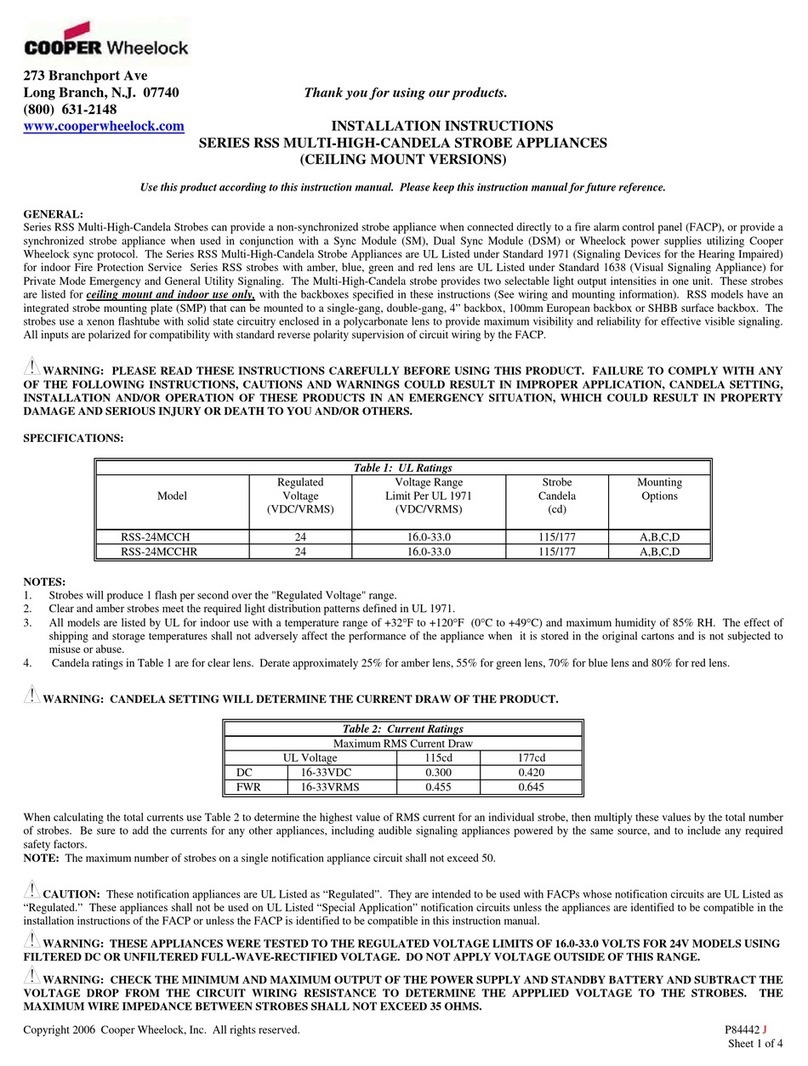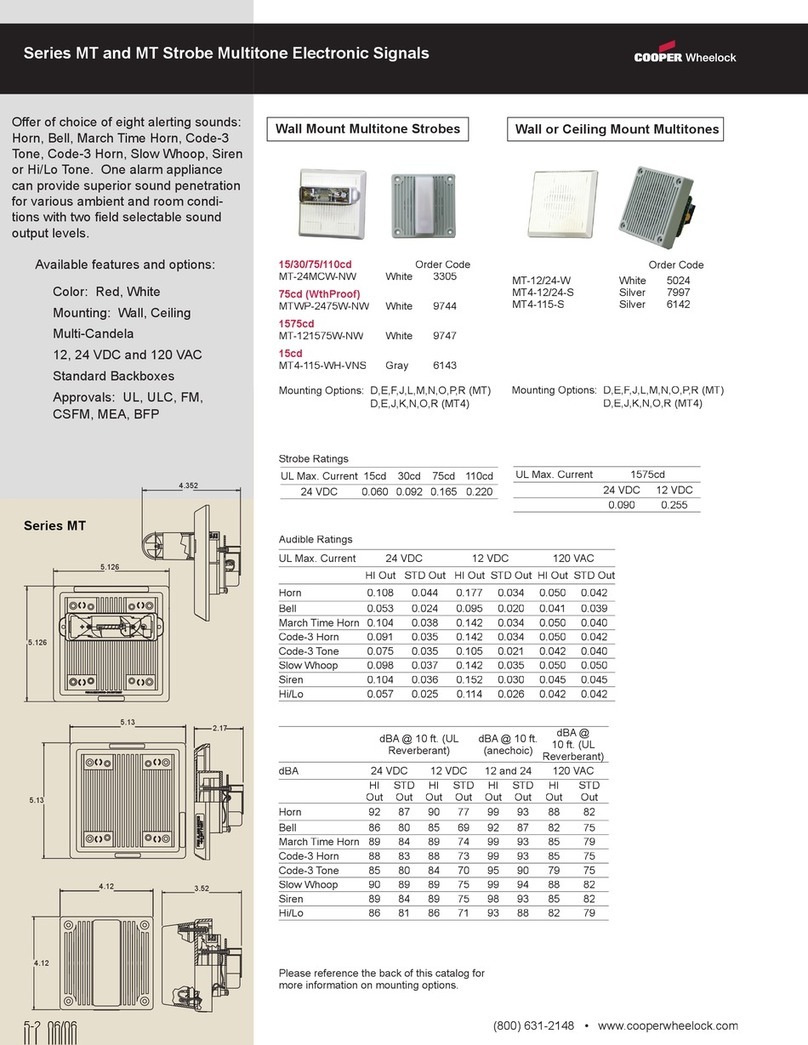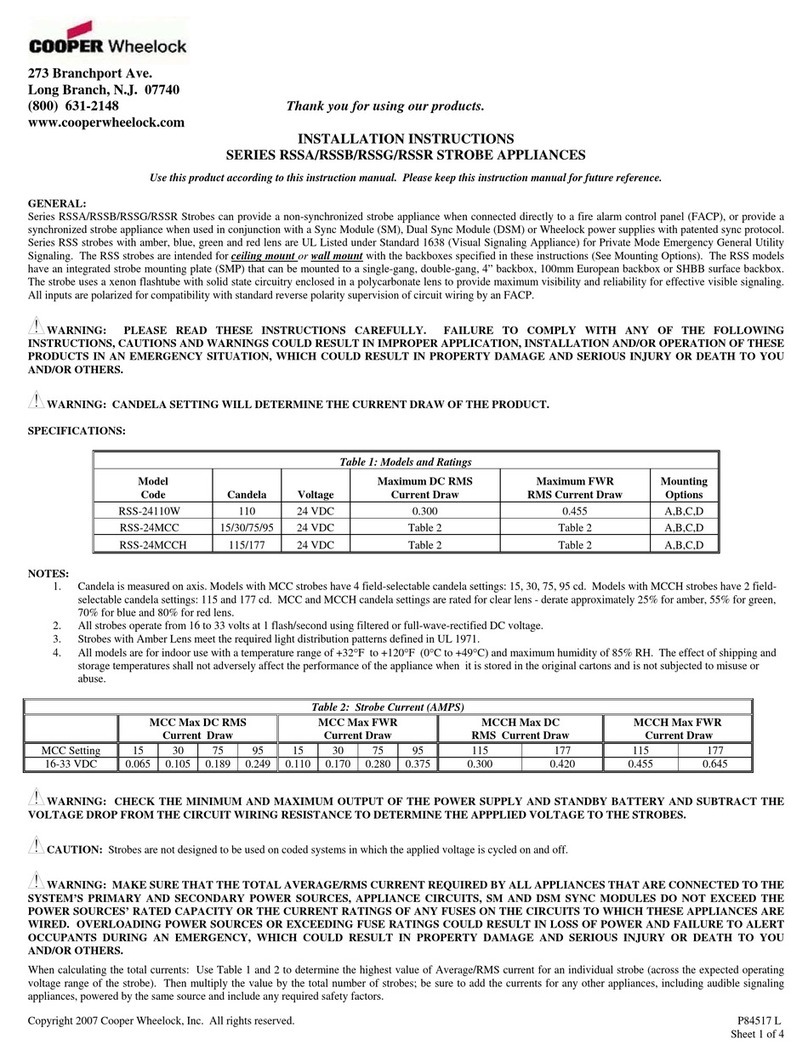
P84478 J
Sheet 4 of 4
WIRING PROCEDURES:
CAUTION: Check that the installed product will have sufficient clearance and wiring room prior to installing backboxes and conduit, especially if sheathed
multiconductor cable or 3/4" conduit fittings are used.
1. Set each speaker to the required wattage and voltage according to Table 3.
2. To insure proper speaker phasing, maintain a consistent color code to all speakers. To simplify phasing, use interconnecting cable with color coded wires.
A. Connect the same color wire (in the interconnecting cable) to the amplifier output terminal marked COM (Common), and to the "COM" terminal of all
speakers.
B. Connect one other color wire (in the interconnecting cable) to the amplifier output terminal marked 25V or 70V and to all of the “+” terminals at each speaker
input. The setting of “J1” must match the amplifier output of 25V or 70V.
C. If shielded cable is used, then connect the shield (in the interconnecting cable) to the amplifier output terminal marked GND (Ground). The shield is not
connected to the speakers. The shield is made continuous using wire nuts and taped off at the last speaker on the cable run.
3. The total system wattage requirement should not exceed 85% of the system amplifier’s rated output. The total system wattage requirement is the summation of
the wattage tap selections of all system speakers.
4. When terminating field wires, do not use more lead length than required. Excess lead length could result in insufficient wiring space for the signaling appliance.
5. Set the strobe to the required candela. To move selector switch, insert screwdriver into slot shown on the side of the strobe. The setting is indicated by a pointer
and can be seen on the side of the lens. See Figure 7.
6. Conduit entrances to the backbox should be selected to provide sufficient wiring clearance for the installed product.
7. Do not pass additional wires (used for other than the signaling appliance) through the backbox. Such additional wires could result in insufficient wiring space
for the signaling appliance.
8. Use care and proper techniques to position the field wires in the backbox so that they use minimum space and produce minimum stress on the product. This is
especially important for stiff, heavy gauge wires and wires with thick insulation or sheathing.
9. If this appliance is required to produce a distinctive three-pulse Temporal Pattern Fire Alarm Evacuation Signal (for total evacuation) in accordance with NFPA
72, the appliance must be used with a UL864 listed fire alarm control unit. Refer to manufacturer’s installation manual for details.
CAUTION: Always operate audio amplifiers and speakers within their specified ratings. Excessive input may distort sound quality and may damage audio
equipment. Do not exceed +100% of speaker input voltage per UL 1480. Improper input voltage can damage speaker. If distortion is heard, check for clipping of the
audio appliance with an oscilloscope and reduce the amplifier input level or gain level to eliminate any clipping.
WARNING: 1) THESE DEVICES ARE NOT INTENDED FOR USE IN HAZARDOUS LOCATIONS AS DEFINED BY THE NATIONAL
ELECTRICAL CODE (NEC) AND BY THE NATIONAL FIRE PROTECTION ASSOCIATION (NFPA). 2) THESE DEVICES ARE DESIGNED FOR
INDOOR USE ONLY. DO NOT EXPOSE TO RAIN OR MOISTURE.
WARNING: THE SPEAKER STROBE APPLIANCE IS A "FIRE ALARM DEVICE - DO NOT PAINT."
WARNING: WHEN INSTALLING STROBES IN AN OPEN OFFICE OR OTHER AREAS CONTAINING PARTITIONS OR OTHER VIEWING
OBSTRUCTIONS, SPECIAL ATTENTION SHOULD BE GIVEN TO THE LOCATION OF THE STROBES SO THAT THEIR OPERATING EFFECT
CAN BE SEEN BY ALL INTENDED VIEWERS, WITH THE INTENSITY, NUMBER, AND TYPE OF STROBES BEING SUFFICIENT TO MAKE
SURE THAT THE INTENDED VIEWER IS ALERTED BY PROPER ILLUMINATION, REGARDLESS OF THE VIEWER'S ORIENTATION.
FAILURE TO DO SO COULD RESULT IN PROPERTY DAMAGE AND SERIOUS INJURY OR DEATH TO YOU AND/OR OTHERS
The S8-24MCCH’s 177cd setting is Listed for use in sleeping or non-sleeping areas when installed in accordance with appropriate NFPA Standards and the Authority
Having Jurisdiction.
If this appliance is required to produce a distinctive three-pulse Temporal Pattern Fire Alarm Evacuation Signal (for total evacuation) in accordance with NFPA 72, the
appliance must be used with a fire alarm control unit that can generate the temporal pattern signal. Refer to manufacturer’s installation manual for details.
NOTE: NFPA 72/ANSI 117.1 conform to ADAAG Equivalent Facilitation Guidelines in using fewer, higher intensity strobes within the same protected area.
WARNING: A SMALL POSSIBILITY EXISTS THAT THE USE OF MULTIPLE STROBES WITHIN A PERSON'S FIELD OF VIEW, UNDER
CERTAIN CIRCUMSTANCES, MIGHT INDUCE A PHOTO-SENSITIVE RESPONSE IN PERSONS WITH EPILEPSY. STROBE REFLECTIONS IN A
GLASS OR MIRRORED SURFACE MIGHT ALSO INDUCE SUCH A RESPONSE. TO MINIMIZE THIS POSSIBLE HAZARD, COOPER
WHEELOCK STRONGLY RECOMMENDS THAT THE STROBES INSTALLED SHOULD NOT PRESENT A COMPOSITE FLASH RATE IN THE
FIELD OF VIEW WHICH EXCEEDS FIVE (5) Hz AT THE OPERATING VOLTAGE OF THE STROBES. COOPER WHEELOCK ALSO STRONGLY
RECOMMENDS THAT THE INTENSITY AND COMPOSITE FLASH RATE OF INSTALLED STROBES COMPLY WITH LEVELS ESTABLISHED
BY APPLICABLE LAWS, STANDARDS, REGULATIONS, CODES AND GUIDELINES.
CAUTION: Check the installation instructions of the manufacturers of other equipment used in the system for any guidelines or restrictions on wiring and/or
locating Notification Appliance Circuits (NAC) and notification appliances. Some system communication circuits and/or audio circuits, for example, may require
special precautions to assure electrical noise immunity (e.g. audio crosstalk).
NOTE: This equipment has been tested and found to comply with the limits for a Class B digital device, pursuant to Part 15 of the FCC Rules. These limits are
designed to provide reasonable protection against harmful interference in residential installation. This equipment generates, uses and can radiate radio frequency
energy and, if not installed and used in accordance with the instructions, may cause harmful interference to radio communications. However, there is no guarantee that
interference will not occur in a particular installation. If this equipment does cause harmful interference to radio or television reception, which can be determined by
turning the equipment off and on, the user is encouraged to try to correct the interference by one or more of the following measures: 1) Reorient or relocate the
receiving antenna, 2) Increase the separation between the equipment and receiver, 3) Connect the equipment into an outlet on a circuit different from that to which the
receiver is connected, and 4) Consult the dealer or an experienced radio/TV technician for help.
ANY MATERIAL EXTRAPOLATED FROM THIS DOCUMENT OR FROM WHEELOCK MANUALS OR OTHER DOCUMENTS DESCRIBING THE
PRODUCT FOR USE IN PROMOTIONAL OR ADVERTISING CLAIMS, OR FOR ANY OTHER USE, INCLUDING DESCRIPTION OF THE
PRODUCT'S APPLICATION, OPERATION, INSTALLATION AND TESTING IS USED AT THE SOLE RISK OF THE USER AND COOPER
WHEELOCK WILL NOT HAVE ANY LIABILITY FOR SUCH USE.
11/15


























